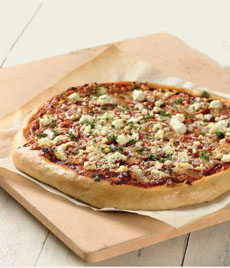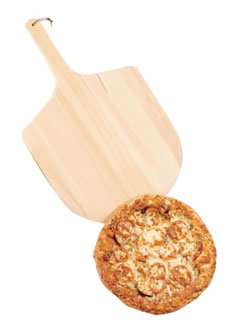TIP OF THE DAY: How To Use A Pizza Stone
 Pizza stones can be square or round. Photo of this top-rated pizza stone courtesy KingArthurFlour.com. |
Here’s a gift for anyone who makes pizza at home—or needs some encouragement to do so. This tip is from Chef Johnny Gnall. If you have questions or suggestions for tips, email Chef Johnny. If you are a true pizza lover, your home should not be without a pizza stone…and a pizza paddle too. If you’ve never used a pizza stone, you don’t know what you’re missing! It’s the only way to achieve restaurant-quality crust at home. A pizza stone makes a great holiday gift for any pizza lover, from the seasoned chef to kitchen beginner. I assure you: it will change the way you eat pizza forever! For those who resist buying single-use gadgets: Rest assured, you can do more with a pizza stone than make pizza. |
|
|
The simple beauty of a pizza stone is its ability to get crazy hot and remain bone dry (crispy!), which are the exact conditions you need for something like pizza crust. Another benefit: Pizza will rarely burn on a stone. More precisely, the crust will burn before the bottom will, so even though you can’t see it, you don’t have to stress out that the bottom is burning while it sits on the blazing hot stone. HOW TO USE A PIZZA STONE The pizza stone should come with instructions, but here’s an overview: |
||
|
HOW TO CLEAN A PIZZA STONE
If you want to make pizza with minimal muss and fuss, you should also own a pizza paddle. Then, along with the pizza stone, you’re ready to compete with the local pizzeria. The paddle, dusted with a bit of semolina flour or cornmeal, is the most effective way to get the raw, stretched pie onto the stone. |
Growing oysters off the coast of Louisiana. Photo courtesy Louisiana Seafood News. |
|
|
WHAT ELSE TO DO WITH A PIZZA STONE Beyond making a pie from scratch, a pizza stone is perfect for getting any number of dough-related items especially toasty and delicious; just think of the idea pizza, and apply that to: Canapés: Small appetizers like crackers and crostinis can get soggy if they sit with toppings longer than intended. A quick trip into a 350°F oven on a pizza stone will bring them back to life, strengthening the base and rewarming the toppings. Make bubbly, mini tuna melts on brioche rounds; remove and plate with ease using a spatula. Cookies: Picture your favorite chocolate chip (or other) cookie, hot from the oven, with a crispy bottom and a soft top, chocolate chips all gooey. A minute or two on a pizza stone will give you just that. Bonus: A crispy bottom stands up particularly well to a milk dunking! Cold/Leftover Pizza: Never again use a microwave to reheat your pizza, and that overly chewy crust that stretches like taffy will become a thing of the past! Five minutes on a hot pizza stone will have your slice tasting like it did when it arrived at your front door or your table at the pizzeria. Pastries: A danish, scone, or other sweet pastry will get hot without getting soggy if you put it on a pizza stone. Keep an eye on pastries with fillings or glazes, as they will conduct heat more quickly and need less time than you might think. |
||
